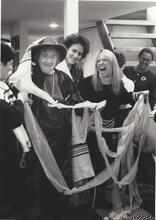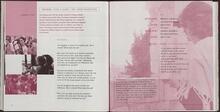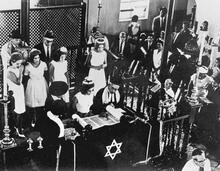Agunot
Agunot are women unable to obtain a rabbinic divorce (get) because their husbands are unwilling or unable to give one, while this is the only halakhic means for divorce. No time limit exists for this status. If agunot enter new relationships, they are stigmatized as adulteresses; children from such relationships are stigmatized as mamzerim, illicit offspring. Get-refusing husbands often extort wives for a get, extortion rabbinic courts often abet. Halakhic marriage annulment exists but rabbinic courts do not deem get refusal or other abuse grounds for it. Theoretically, Diaspora women can disregard the halakhic requirement of a get; in reality, Orthodox women cannot do so because of traditional socialization and fear of sanctions. In Israel, divorce for Jews in only possible with a get.
Introduction
Agunot (agunah, s.) are women who are unable to obtain a rabbinic divorce (Writ of (religious) divorceget; gittin, pl.) because their husbands or their husband’s male next of kin are unable or unwilling to give one, leaving them chained in marital captivity (iggun). The term comes from the Hebrew word for “anchor.”
Under rabbinic law (halakhah), marriage is enacted by the baal (husband; literally, “master”) “acquiring” (kinyan) exclusive rights to his wife’s sexuality and reproductivity from the woman’s father or other male guardian and “sanctifying” (kiddushin) that exclusivity (see birkat erusin in the traditional wedding ceremony). This enactment is unilateral: the woman does not participate in the wedding ritual except to accept a ring of minimal value, by which she signals acceptance of the groom’s kinyan, and she has no parallel claim to his sexuality or reproductivity. The woman does not marry her husband; she is married to him in a ceremony whose legalities are enacted entirely and necessarily by men, in order for them to be halakhic.
Halakhic marriage being unilateral, effected by the husband, so, too, is halakhic divorce. It is the husband’s prerogative to end the marriage by giving his wife a get. Halakhah requires that the husband grant a divorce knowingly and willingly. If the man is mentally or physically incompetent to give a get, or if a husband goes missing, e.g., on a trip or in war, without halakhically valid witnesses to his death, his wife is an agunah. There is no time limitation on either circumstance and no presumption of death, of either the man or the marriage, because of the passage of time. If a man refuses to give a get, the woman becomes an agunah.
Another route to iggun (the state of being an agunah) is through the failure of levirate marriage to occur. A widow whose marriage was childless is required, under halakhah, to marry her deceased husband’s next male kin (levir). Should he not marry her, and not release her to marry someone else through the ritual of Mandated ceremony (Deut. 25:9halizah, the widow is an agunah, even though her husband is dead. Yet another route to iggun is if the husband converts to another religion and does not give his wife a get.
Should an agunah enter into a relationship with another man, she becomes an adulteress. Halakhah defines adultery according to the woman’s marital status (if a married Jewish man has sex with an unmarried Jewish woman, neither is an adulterer). The offense of adultery is committed only if the exclusive sexual rights of a husband are violated.
The category of adultery carries profound stigma and triggers financial consequences for a wife. Halakhah requires divorce of an adulterous wife but denies her the right to collect the value of her ketubbah (marriage contract), which includes a provision for support in case of divorce. In Israel, which lacks civil marriage and divorce and where Jews can divorce only with a get, if a rabbinic court also handles the financial settlement and child custody—which can be settled in family court—a woman labelled as “adulterous” will suffer severe punitive consequences.
Adultery also carries stigma and social consequences for subsequent generations. Should a married woman have children with any man but her husband, halakhah deems those children mamzerim, illicit offspring, who are not permitted to marry any Jew but another mamzer/a. (The category of mamzerut applies only to Jews and does not apply to the offspring of two Jews when the woman is unmarried.) On the books, at least, this stigmatic status and shunning are transmitted for generations. In Israel, where the State-recognized Chief Rabbinate keeps “mamzer lists,” the Rabbinate refuses to marry such people. (They can marry abroad and return to Israel and register as married with the Ministry of Interior or use common law marriage, yedu’im be’tsibuur).
The taboo of adultery and mamzerut for children prevents many agunot from proceeding with their lives and is a chief tool in forcing them to agree to ruinous divorce terms: to pay ransom in order to obtain a get. Agunah activists have reported otherwise unwanted abortions resulting from fear of the stigma of mamzerut.
New terms, mesorevet get for a woman who has been refused a get by a husband and mesarev get for the husband, distinguish cases of refusal from the archetypal cases in halakhah of a missing husband. However, the women in all these instances, as well as in cases where levirate marriage is not enacted or in which husbands convert without giving a get, remain agunot under halakhah: their marital status is “married.”
Get Extortion
Extortion by husbands to grant a get, facilitated and abetted by rabbinic courts, is a serious problem, the result of the man’s privilege to grant a get and the consequent power imbalance between the spouses. It appears to have worsened in recent decades, in part because the overall wealth of the Jewish community has increased, making the sums demanded in payoffs for gittin often exorbitant. In one widely reported 2019 case, Israel Meir Kin, a then-fourteen-year get refuser in California, demanded half a million dollars and custody of the couple’s minor child. He denies he was withholding a get (or that she was an agunah), saying that he is offering one and she refuses to accept. A reported one-third of Israeli women experience some form of extortion to receive a get.
Given the 1953 law establishing religious jurisdiction over personal status, the State of Israel refuses to become involved in cases in which a woman’s freedom is withheld, thus enabling and encouraging get extortion. The State not only turns a blind eye to get extortion but even endorses it, in the words of Susan Weiss, Founder and Director of the Center for Women’s Justice in Jerusalem, “as a valid, efficient, and religiously acceptable method of divorce resolution. Blackmail does not invalidate a Jewish divorce” (unless, of course, such tactics are exercised by the wife, which would infringe on the husband’s “free will” in the matter) (Weiss, pp. 58-59).
Israel gives religious law supremacy even over its “Basic”(that is, constitutional) law on “Human Dignity and Liberty,” which states, in part: “There shall be no violation of the life, body or dignity of any person as such; there shall be no violation of the property of a person; all persons are entitled to their life, body, and dignity; [and] There shall be no deprivation or restriction of a person by imprisonment, arrest, extradition or otherwise.”
Outside of Israel, the ability of secular courts to intervene depends on the relationship between religion and state, and on individual states’ laws governing marriage and divorce.
In The Wed-Locked Agunot, Orthodox agunah activists Susan Aranoff and Rivka Haut cite case after case in the United States of rabbinic courts abetting get extortion, a phenomenon they call “the open institutionalization of extortion.” “The idea,” they note, “that it is acceptable for men to put a price tag on the get was so widely accepted that Rabbi Yehuda Levin, director of Get Free… unabashedly described himself as a ‘negotiator’ whose mission was to obtain a get for a woman at the lowest possible price.” Get extortion, they report, “is so widely accepted by rabbis that they actually solicit ‘charitable’ donations for that purpose,” thereby encouraging hostage taking and blackmail of women (Aranoff and Haut, 71).
Outs for Men
An expedient developed in medieval Ashkenaz (Franco-Germany) allows the man to marry a second wife without divorcing the first in cases where the wife refuses to receive a get or is incapable of receiving one—if 100 rabbis in different communities agree to lift the ban against polygamy, instituted in the tenth century for Jews who follow Jews of European origin and their descendants, including most of North and South American Jewry.Ashkenazi legal custom (heter meah rabbanim). The man in the above-mentioned case in California did so. He remarried; she remains an agunah.
If the husband follows Descendants of the Jews who lived in Spain and Portugal before the explusion of 1492; primarily Jews of N. Africa, Italy, the Middle East and the Balkans. [jwa_encyclopedia_glossary:394]Sephardic/jwa_encyclopedia_glossary] or Lit. "Eastern." Jew from Arab or Muslim country.Mizrahi minhag (halakhic custom), an even easier “out” exists. No halakhic ordinance in these Jewries bans polygamy. If a rabbinic court authorizes a second marriage for a man, he may do so. The Israeli State will even waive the ban in criminal law against polygamy in such a case.
Extent of the Problem
Obtaining a full, accurate count of the number of agunot is impossible. First, no central authority has ever kept such records for Jews. Each rabbinic court in a Lit. (Greek) "dispersion." The Jewish community, and its areas of residence, outside Erez Israel.Diaspora community conducts its own affairs. Aranoff and Haut attempted to help 2,000 agunot over the course of 30 years (beginning roughly in 1985). They averaged 60-70 calls from agunot annually, most from the United States but also from Latin America, Israel, and Europe. The Organization for Resolution of Agunot (ORA), based in New York, reported in 2014 that it received 150 calls a year from agunot. A survey conducted by the Melman Group of Jewish social service organizations in the United States and Canada reported these organizations had been contacted by 462 agunot in the previous five years, with one-third occurring in 2011. A 2013 survey in Israel cited evidence of get extortion in thousands of cases.
Rabbinic authorities also dispense and withhold the term “agunah” as a means to minimize and deny the problem. Rabbinic courts label a woman who refuses an extortionist get deal not an agunah but a recalcitrant, responsible for her own predicament; her husband and/or the rabbinic court that pressured her to accept the deal are portrayed as victims. Fully adjudicating a case can take years—extending the length and cost of proceedings is a major tactic of get extortion, as well as a means of financial gain for the court—and even then the woman is not always classified as an agunah.
The Editors of the Jewish Week reported in 2011, “In Israel, estimates of 10,000 agunot have been reported by the Wall Street Journal and the Jerusalem Post, in contrast to claims by [the ultra-Orthodox] Agudath Israel, that there are 180 in the Jewish state, and remarkably, an equal number of men who are being refused divorces by their recalcitrant wives.” They also quoted Israeli attorney Batya-Kehana Dror, director of the Mavoi Satum divorce rights group, on what she describes as a fundamental error in how the rabbinical courts determine recalcitrance by a husband. Courts only consider a spouse to be recalcitrant after a rabbinical court has ruled a divorce must be issued or accepted; it may take many years after a divorce suit is filed for the court to issue such a ruling, which in any case is a rare event. In many cases, the rabbinical court is attentive to a man’s request to try reconciliation, delaying a decision requiring him to grant a divorce, even in cases of violence against the wife.
Dror also argued that the rabbinical courts treat men leniently and often fail to issue rulings requiring them to give a divorce, reducing the chance they will refuse and be labelled “recalcitrant” (mesarev). In one egregious case Mavoi Satum handled, the Jerusalem Rabbinical Court refused to require a husband, who had beaten his wife on three occasions, to grant her a divorce; the judges refused to accept her request, saying that he had beaten her simply because she asked for a divorce, and it accepted his assertion that he would not repeat his behavior.
Apologists for the system regularly deny the existence or extent of the problem, including with claims of equivalency in numbers of men supposedly held in marriages against their will, omitting reference to the several ways closed to women by which men can extricate themselves from marriage when the wife is unwilling or unable to cooperate.
The problem of iggun has worsened because half of all Jews today live in Israel, where the State-recognized rabbinate rules by halakhah and rarely applies halakhic expedients to free agunot. Independent An ultra-Orthodox Jewharedi courts (which are technically illegal but operate de facto) are said to be more forthcoming in their methods, but no published studies about this exist.
Conditional Divorce and Other Protections for Women
Although a fundamental rabbinic principle holds that valid divorce is effectuated only through the exercise of the husband’s free will, under halakhah a woman may ask her husband for a divorce and, in certain circumstances, a rabbinic court may “force” him to grant one. Such circumstances include if the husband has an illness with revolting symptoms or an occupation that leaves him reeking of a repellent odor (that is, if he becomes sexually repellant to her); if he is impotent or infertile; if he withholds the rights due her in the ketubbah; if he abuses her physically or verbally; if he forces her to violate a religious precept or becomes an apostate; and if he wishes to move to a location she does not wish to inhabit.
The pre-modern, autonomous Jewish community (kehillah) had extensive powers of coercion, including jail, corporal punishment, fines, and shunning, which made social, religious, or economic life for those defying the community's authority untenable. These means could induce a man to grant the get “through his own free will.” A tenth-century Regulation supplementing the laws of the Torah enacted by a halakhic authority.takkanah attributed to Rabbenu Gershom further limited a husband’s prerogatives by prohibiting divorce of a woman against her will; another takkanah attributed to him barred polygamy.
Women’s vulnerability in marriage and divorce were ameliorated in part by the increasing power and correspondingly expanding rights of women in medieval Jewish societies, in both Christian and Muslim realms. In the Ashkenazi world, the significant economic role Jewish women played in commerce and money lending gave them power and standing to demand and receive greater say about the conditions of their marriages and divorces; Jewish tolerance there was conditioned on ability to deliver economic benefit to non-Jewish authorities, and women’s vital economic contributions gave them (or their male guardians) negotiating clout to demand significant protections.
Even in the Middle Eastern world, patriarchy itself could protect women’s rights, evidenced in far-reaching prenuptial negotiations and agreements that go well beyond Lit. "teaching," "study," or "learning." A compilation of the commentary and discussions of the amora'im on the Mishnah. When not specified, "Talmud" refers to the Babylonian Talmud.Talmudic law in protecting a wife’s right to refuse a husband’s intent to relocate, marry an additional wife (since no Sephardi or Mizrahi halakhic ordinance prohibited polygamy, any such limitation resulted from negotiation between the parties), stop her from visiting her family, or demand that she account for household possessions upon his return from business trips. Significantly, the requirement that men going on extended trips deposit a conditional bill of divorce was also established. In the far-reaching prenuptial contracts in the Cairo Geniza (actual documents between marital parties in Egypt, Palestine, Syria, and elsewhere in the Middle East), fathers, brothers, and uncles insisted on protections for their female kin-- their legal wards—because if the woman was divorced or became an agunah, she returned to their house and became their financial liability, or that of the male-run community as a whole.
Divorce and iggun in pre-modern Jewry, European or Middle Eastern, were not simply women’s problem. They were not a moral (soft) problem but a financial (hard) one. Iggun had severe financial costs that men were unwilling to bear and had to be limited, and conditional divorce became a normal feature in both Ashkenazic and Middle Eastern medieval societies. Shared interest even moved male kin to help Jewish women appeal to Muslim courts for better terms than they could get in rabbinic ones, despite strong formal strictures against Jews appealing to non-Jewish justice systems.
A Worsening Problem
In the modern period (beginning roughly at the turn of the nineteenth century, with the demise or serious weakening of the autonomous kehillah in Europe), arguably the problem of iggun has worsened, for several reasons.
Desertion
Modern mechanized mass transit enabled migration on a scale impossible previously. Mass Jewish emigration from eastern to central and western Europe, England, Argentina, South Africa, Canada, and the United States in the late nineteenth and early twentieth centuries was accompanied by an increasing number of abandoned wives, whose husbands departed for new worlds and failed to divorce them. In locations where they were not known and where communal controls had ceased to exist (or had never existed, as in the United States), men simply married anew.
Haim Sperber identified 5,348 cases of agunot in or originating in eastern Europe in the second half of the nineteenth century and 3,652 in the early twentieth century, many made agunot through desertion. In 1867, the newspaper Hamaggid, first published in Lyck, Prussia, began featuring a dedicated last page on which it printed appeals from agunot seeking their husbands. The paper’s editor wrote articles calling attention to the problem. Fathers of agunot and rabbis also placed ads on behalf of agunot seeking their husbands. Aside from wanting to help desperate women, these rabbis feared the unraveling of traditional society and their authority through disregard of its norms.
Desertion contributed mightily to already high levels of Jewish impoverishment in eastern Europe and immigrant communities abroad, increasing the calls of destitute women and children on community assistance. In 1905, the National Council of Hebrew Charities in New York created the National Desertion Bureau because of this growing problem. In Kiev, 13% of applicants for communal welfare in 1913 were deserted wives (just one category of agunot). Unlike in the medieval period, when social pressure could protect Jewish society and women from the cost of iggun, in the absence of the pre-modern, autonomous kehillah such expedients declined or disappeared.
“For our many sins,” begins an undated letter of this era of Rabbi Moshe Nahum Yerusalimsky, sent from somewhere in the Pale to Western rabbis,
there are some who have breached the bounds of decency and have cast off the obligation to support their families… Among them are men who know no discipline, and who have taken themselves other wives in place of those they betrothed according to the law of Moses and Israel… An outcry has reached us from many towns and cities from living widows, left without support from their husbands and without anyone to hear the wailing of … children asking for food (cited in Freeze, 201).
Similar announcements, pleading for information to locate husbands, appeared in Yiddish newspapers in the US and other places of mass Jewish immigration. The important Yiddish newspaper in New York, Forverts, published a “Gallery of Abandoning Husbands,” a list of deserters with their details and photographs.
War and Other Causes
War is always the occasion for the undocumented disappearance of husbands and the creation of agunot. Jewish men were combatants in the armies of all the countries that fought in World War I, whose eastern front was the Jewish Pale of Settlement. Women who became agunot could become prostitutes, lured through deception or desperation. Yiddish novels also leveled “criticism at Jewish customs that abetted traffickers—matchmaking and the orthodox law of divorce,” which created agunot.
Jewish men who converted could remarry (non-Jewish women) without granting their Jewish wives a get. Such men were outside Jewish communal control; indeed, churches in Imperial Russia encouraged swift remarriage to Christians in order to lessen the chances of family pressure against the conversion or to give the wife a get. Indeed, in Imperial Russia, extensive breakdown of marriage derived from multiple causes and was expressed in various ways; the agunah problem was exacerbated but hardly caused by the era’s mass emigration.
Refusal of a levir, Jewish or converted, to either marry his childless deceased brother’s wife or formally release her from obligation to marry him has always been another source of iggun, as has monetary benefit for men; many men refused to divorce wives simply to avoid the obligation to repay the wife’s dowry and pay the ketubbah. Unsafe conditions led to the demise of many Jewish men, and without witnesses establishing the death, such women were agunot without hope of release.
Get blackmail existed, too. A rabbi in Russia wrote to his counterpart in New York about a man who had failed to send back support for his family and demanded a thousand rubles to divorce his wife. “’I have spoken to the woman’s father, who is a poor man,” the rabbi wrote. “Nevertheless, he told me that to secure her release… he would sell everything he has and would give the man 100 rubles. If that is not enough, he will try to obtain help from his relatives, perhaps another 200 rubles” (cited in Freeze, 232).
In her memoirs, Pauline Wengeroff (1833-1916) recalls a childhood Purim skit she put on in her wealthy home in which she played an agunah pleading for food during her family’s lavish Purim feast. Clearly, to have figured so in the faculties of a child, the phenomenon, and its association with female poverty, was common. References to agunah cases, most not caused by desertion, are also plentiful in the responsa of major halakhic authorities.
A recent extensive work by Noa Shashar, based on responsa literature and the rulings of rabbinic courts in Ashkenazic communities from 1648 to 1850, demonstrates conclusively that rabbinic courts did not, as is often claimed, turn every stone to free agunot.
Efforts to Address the Problem
The problem of iggun persists not because of a lack of halakhic solutions, Aranoff and Rivka Haut assert, but because rabbis fail to apply them. They cite instances of halakhic creativity in other areas, in particular to allow certain business arrangements barred by Biblical ordinance, such as charging interest to other Jews.
The problem of agunot was a central topic at conferences organized by women’s organizations in the 1920s: Bnos Agudath Israel (in Lodz); the Vienna Women’s Conference (part of the second World Congress of Agudath Israel); the World Conference of Jewish Women (in Hamburg); and the Women’s International Zionist Organization (WIZO), meeting in Zurich.
Dr. Ada Reichenstein, a delegate from Lemberg, Poland, to the World Congress of Jewish Women in Vienna in 1923, described the “question of Jewish marriage and divorce [as] an ostjuedische [eastern European] catastrophe.” Some 25,000 women in Congress Poland alone had husbands who had disappeared during World War I and who could not remarry because the deaths had not been confirmed by halakhic criteria. Bertha Pappenheim, Orthodox founder of the mass-membership German Jewish women’s organization the Juedischer Frauenbund, which operated from 1904 till its dissolution by the Nazis in 1938, “petitioned rabbis to modernize marriage, divorce and inheritance laws for the sake of the approximately 20,000 agunot in eastern Europe, who ‘were living in misery’” (Seidman).
At the International Conference for the Protection of Jewish Girls and Women in 1927, Pappenheim spoke vehemently about the failure of the rabbinate to address this issue:
We have at this meeting several rabbis from Eastern Europe, and I had hoped that they would listen to us, and do something to improve the difficult position of so many Jewish women. It is not only a question of ‘agunoth’, but also of facilitating divorce. I had hoped that a Sanhedrin of Rabbis would come together, and that they would introduce the needed ritual reforms, and re-organize Jewish ceremonial dealing with this matter. That is what I had hoped, but I have been told that we must not expect it, for the rabbis do not have the power to introduce the changes asked for. In that case we must continue to flounder within this ‘golus’ [exile], but it is a ‘golus’ within a ‘golus’ (cited in Seidman).
Pappenheim was unpersuaded that the rabbis were incapable of addressing the problem, and she was angry that they would reform Jewish law to facilitate business but not to assist women.
Polish Jewish women also took up the cause of agunot on their home ground. Leah (Levin-Epstein) Proshansky published about the problem for the Warsaw-based monthly Froyen Shtim (Women’s Voice), whose 1925 inaugural issue called attention to the problem, scoring in particular rabbinic inaction about the problem of abandoned wives left undivorced by emigrating men. Like others, she castigated rabbinic willingness to bend halakhah in other ways while refusing on behalf of agunot.
In 1981, Blu Greenberg, in the first book-length treatment by an Orthodox feminist on women and halakhah, a work simultaneously of critique and apology, devoted a chapter to divorce and halakhic solutions to iggun. Applying her signature pronouncement about the issue of women and halakhah, she concludes that the failure of Orthodox rabbinic authorities to obviate the problem of iggun “bespeaks a lack of rabbinic will to find a halakhic way.”
A variety of Orthodox organizations have operated on several continents to help agunot obtain a get. In the United States, these include G.E.T. (Getting Equitable Treatment); Agunah, Inc.; ORA (Organization for Resolution of Agunot, Inc.); the Jewish Orthodox Feminist Alliance (JOFA); Agunah Inc.; Agunah International; L’Maayan B’nos Yisroel International. Canada is home to Canadian Coalition of Women for the Get). In the United Kingdom, Agunot Anonymous Educational Foundation, Agunot Campaign, and Getting Your Get are dedicated to the problem. Israeli organizations that advocate for agunot are The Center for Women’s Justice; Mavoi Satum; International Jewish Women’s Human Rights Watch; and Yad L’Isha ITIM. The Ruth and Emanuel Rackman Center for the Advancement of Women’s Status-Agunah International and the International Coalition for Agunah Rights (ICAR) operate internationally. The methods, affiliations, and political and financial backing of these organizations vary but all abide by the limits of halakhah and use halakhic courts (batei din).
While theoretically, Orthodox and ultra-Orthodox women outside of Israel can choose whether to abide by halakhah when they become agunot, in reality profound socialization and severe strictures for violating halakhic norms, especially in the fraught area of sexual boundaries and legitimacy, make such choice largely theoretical. In addition to the taboo of adultery and the stigma of mamzerut, family and community shunning (herem) in personal relations; loss of inheritance, job, career, and membership in the community and synagogue of one’s birth, and expulsion of one’s children from religious schools are all consequences of transgressive behavior. Agunot and those who work to help them within Orthodox worlds operate within these constraints, which add to the already enormous power imbalance that disadvantages women in this system.
Orthodox agunah advocates use a number of tactics to try to free agunot. These include appealing to the rabbinic court involved in a case and citing circumstances that warrant requiring that the husband appear before the court (which does not guarantee a get), or that the court order that he give a get (hiyyuv gett). The latter is exceedingly rare, used only after prior proceedings extending over years. If the husband proves recalcitrant, the court may approve shaming efforts in an attempt to pressure his compliance: publicizing the man’s name and face, demonstrating in front of his home, workplace, and/or synagogue, or demanding that he be denied synagogue participation or honors. In a few instances, women have refused to go to Ritual bathmikveh as a pressure tactic on their communities to force a recalcitrant husband to give his wife a get.
In Israel, the Chief Rabbinate has the power to levy fines, freeze assets, have a driver’s license or passport suspended, and jail a husband who ignores its summonses and orders. Some though not all men bow to such measures, which are taken only after much time has passed in hearings and other efforts. Aside from the toll of such proceedigns on the woman, the time that elapses bears on her desire to pursue other relationships and have children. These factors often induce women to agree to ruinous get deals in order to free themselves.
ICAR, The International Coalition for Agunah Rights, declared the Fast of Esther “International Agunah Day,” on which it conducts the following activities:
- Advocating legislation to declare the Fast of Esther as International Agunah Day;
- Initiating and promoting public events, presentations, demonstrations, rallies, and exhibitions;
- Initiating a special event or meeting in the Knesset;
- Mobilizing a media campaign;
- Distributing pamphlets containing special prayers at synagogues and during demonstrations;
- Promoting a nation-wide study day;
- Organizing protests in front of the Lit. "assembly." The 120-member parliament of the State of Israel.Knesset and/or the homes or work place of offending husbands.
Critics say that, however unintentionally, efforts to ritualize the plight of agunot in “Agunah Days” mapped onto the Fast of Esther normalizes the problem, making its commemoration a fixture on the religious calendar, rather than ending it.
Pre-Nuptial Agreements: “The Dangerous Illusion”
The modern Orthodox world in the United States began elaborating pre-nuptial agreements in 1983, when Rabbi J.D. Soloveitchik approved a version for use by rabbis in the Rabbinical Council of America (RCA). This agreement stated that if a husband refused to give a get after the couple had divorced civilly, fines in the amount of $250 a day, indexed to inflation, would accrue to him. Despite the RCA’s failure to promote the prenup (it does not require its members to request that couples use it, much less mandate that they do so), and considerable communal resistance, it has made some headway within modern Orthodoxy, pressed by families.
According to Rabbi Joel Weissman, director of the RCA-affiliated Beth Din of America (BDA), the fines stipulated in its prenups are almost always waived in exchange for a get. The BDA exercises absolute control over the payment of such fines and waives them at its discretion, leading Susan Aranoff to protest that “they are emasculating their own prenuptial [agreement].” The ultra-Orthodox Agudath Israel of America does not advocate use of halakhic prenuptial agreements.
The Center for Women’s Justice (CWJ) in Jerusalem has devised a prenuptial agreement considered the best available. It has the rabbinic approbation of the eminent Talmud scholar Professor Rabbi Daniel Sperber, a maverick who has several times convened his own beit din to free agunot stymied in the Chief Rabbinate’s system. The CWJ prenup combines monetary fines for non-issuance of a get with post-facto annulment of the marriage when the couple has not resided together for eighteen months. It obligates the couple to take all matters but the get itself to Israeli Family Court for adjudication, in order to keep money, property, and child custody outside the jurisdiction of rabbinic courts, greatly lessening the possibility of get extortion.
Even the best of prenuptial agreements are contracts and, like any contract, can be violated. Attempted enforcement of prenups often entails prolonged, expensive litigation, the threat of which, in particular by a husband of means, can be used as a means of get extortion. To men of means, a prenuptial agreement’s monetary fine is not a deterrent. To men without means, such a fine is unenforceable and therefore meaningless. The problem of states refusing to recognize, much less enforce, a contract produced by a religious system, even if its particulars are financial, remains. These limitations lead to Aranoff and Haut calling prenuptial agreements a “dangerous illusion.” Moreover, prenuptial agreements do nothing for couples already married.
The Conservative movement (called Masorti in Israel), which also rules by halakhah and uses kinyan and kiddushin to effect marriage, has taken an assertive approach toward ending iggun through the use of prenuptial measures. The first such effort was proposed in the United States by Rabbi Louis M. Epstein in 1935. Epstein had studied in one of Europe’s foremost yeshivot and was an acknowledged scholar of rabbinic family law. He proposed adding a codicil to the ketubah that, under specified circumstances, would empower a woman to write her own get, her husband having pre-appointed his wife as his shaliah [agent] to do so. The proposal generated enormous criticism, less because of its content than because of what was seen as the “insolence” of the Conservative rabbis who had not secured prior Orthodox approval.
Women’s rights became sidelined to the question of male authority in denominational power struggles. A similar effort in 1953, by the eminent Talmudist Rabbi Saul Lieberman, met a similar fate to Epstein’s. Lieberman proposed that a clause be added to the ketubah obligating a divorcing couple to bring their dispute to a specified rabbinic court for arbitration, citing but not specifying financial consequences to the husband if he did not cooperate in granting a get.
The Conservative movement adopted the Lieberman clause, which initially had the agreement of the renowned halakhist and leader of modern Orthodoxy, Rabbi J. B. Soloveitchik. But the ultimate refusal of Orthodox authorities to accept it was political: accepting a proposal that emanated from a halakhist associated with the Conservative movement, however great his stature, was taken to signify Orthodox imprimatur on that movement. Soloveitchik withdrew his endorsement of the Lieberman clause under pressure by the Orthodox Rabbinical Council of America (RCA).
Basing itself on the expedient of t’nai bekiddushin, conditional kiddushin, developed by Rabbi Eliezer Berkovits, an Orthodox authority widely shunned in the Orthodox world for his liberal rulings on women’s rights, the Conservative movement has also turned to retroactive annulment of marriages, hafkaat kiddushin, a classic halakhic option, in cases where the husband refuses to give a get or the wife refuses to accept one. Berkovits’s condition states that if the marriage ends in civil divorce, within six months of which, the husband gives the wife a get, the marriage will be considered to have been valid. But if no get has been given after six months of civil divorce, the marriage will be considered to have been null and void (annulment has no consequences for the status of children born of the marriage). The Orthodox establishment vehemently rejected this method, too.
Divorce in Reform and Reconstructionist Judaism
The Reform movement gives primacy to individual conscience rather than to halakhic authority and, from its origins, recognized civil divorce as ending religious marriage enacted under its or any rabbinic auspices.
The Reconstructionist movement offers egalitarian gittin and prefers that couples get divorced in a ceremony using such a document, in addition to civil divorce. If one party is unwilling or unable to participate in these proceedings, the movement will recognize civil divorce alone, though individual Reconstructionist rabbis differ about their willingness to conduct subsequent nuptials if the previous marriage has not been terminated with a get. A Reconstructionist get can also be given unilaterally when one party refuses or is unable to participate.
Israel
In Israel, the lack of civil marriage and divorce makes the situation fundamentally different from the Diaspora. Flouting these authorities in the case of marriage has become increasingly common. But even if the couple goes abroad to marry or has friends or Masorti or Reform rabbis conduct the ceremony, if they register as married with the Ministry of Interior, they will land in Orthodox rabbinic courts in the event of divorce.
Violence and Sexual Abuse
Egregious abuse often occurs in cases of iggun. Aranoff and Haut detail the case, widely reported in the United States press, of Blima Zitrenbaum, found unconscious in her apartment in Monsey, New York (an ultra-Orthodox neighborhood), one Sabbath morning in 1996, bludgeoned and bloody. Police suspected her estranged husband Joseph, a drug addict, against whom Blima had previously obtained an order of protection and who was wanted by the police for other crimes. Aranoff and Haut already knew of Blima because she had sought a get and “appealed to several rabbis” for help in obtaining one. However, “the rabbis maintained that, without Joseph’s consent, they could not release her from her marriage bonds. Even after Joseph was convicted of attempting to murder her, the rabbis held that Blima must remain married to him until he agreed, of his own free will, to give her a gett.”
Indeed, violence against women, of any level, is not considered grounds for a rabbinic court to issue even a hiyyuv gett, an order for a husband to issue a get, much less order sanctions meant to force his giving one (k’fiyyat gett), using sanctions such as, outside Israel, shunning, which the offender’s community could enact, and in Israel, State-enforced financial and other penalties or jail.
Attorney Nitzan Caspi Shiloni of the CWJ relates a case in which a husband pursued his wife with a knife and the rabbinic court to which she turned refused a court-forced get on grounds that the husband had not been duly warned, twice, in the presence of witnesses, against murdering his wife. Furthermore, the court stated, it was not established that he meant to murder her.
In divorce cases in which rabbinic courts adjudicated child custody, such courts have also ruled sexual abuse by the husband of a couple’s children irrelevant, with women ordered either to agree to the father’s access to and even custody of children (even when a secular court ordered that there be no contact) or be denied a get or any financial settlement.
Rabbinic Malfeasance
Zviya Gorodetsky was an agunah for twenty-six years in Israel. Her husband was in jail for nineteen years for defying a rabbinic court order to give her a get. Zviya declared a hunger strike in front of the Knesset in the summer of 2017 to try to rouse the Israeli Parliament to action; her effort failed. She was finally freed through the efforts of Nitzan Caspi Shiloni of the CWJ. Shiloni enlisted Rabbi Daniel Sperber, who convened his own rabbinic court (the other participants have not disclosed their identity for fear of retribution by the Chief Rabbinate), which annulled her marriage after finding numerous, glaring halakhic irregularities in its performance. During Gorodetsky’s long ordeal, no other rabbi had inquired into those irregularities, some of which were automatically disqualifying under halakhah. Instead, they preferred to engage in a power struggle with her jailed husband.
Once her marriage was annulled, Gorodetsky withdrew her request with the Chief Rabbinate court for a get, closing her file. Grounds no longer existed to keep her former husband in jail for get refusal. The Chief Rabbinate, however, incensed that an independent rabbinic court did what it had not, did not recognize the annulment and sought to keep the man in jail, that is, to re-instate her as an agunah.
On the rare occasions that established rabbinical authorities use halakhic remedies to free an agunah, they do so in ways that assure such action is not easily replicated. Oded Guez, despite having his name and photo publicized on the internet and being socially excommunicated, fired from his job, pursued by Interpol, arrested in Belgium, and extradited to Israel, continued to refuse to give his wife a get. After five years of asking for a get, she was finally freed, only when a Chief Rabbinate court, in a very rare move, declared her marriage null. The court, however, refused to publish the grounds on which it annulled the marriage, lest they be applied in other cases.
Rabbi David Golinkin, a Masorti halakhic expert, and the movement’s Center for Women in Jewish Law have published studies, based on actual cases in the rabbinic courts with identifying information of the principals obscured, in which they cite a variety of halakhic expedients and responsa of major halakhic decisors that could be applied in such cases to end the marriages. They aim to pressure the courts to publish their decisions and encourage others to use all halakhic tools to free agunot. But the Orthodox establishment refuses to listen to anything emanating from the Masorti movement, however substantiated by halakhic rulings of pre-modern and of Orthodox and haredi decisors.
The Role of Intra-Denominational Politics and Rivalries in Aborting Solutions in the Orthodox World
Several Orthodox rabbis have attempted forthright resolutions to free agunot and potentially to end iggun. In 1997, Rabbi Simcha Meir Feldblum published a proposal for an alternative to kinyan and kiddushin that would obviate both iggun and mamzerut. It had no practical results. At the same time, Rabbi Moshe Morgenstern of New York initiated his own rabbinical court, headed by Rabbi Emanuel Rackman. The agunah advocacy group Agunah Inc. referred dozens of cases to this court, which resulted in a near 100% rate of resolution, using various halakhic methods. Three hundred women were freed during the court’s existence.
Other rabbis in the ultra-Orthodox world, notably Rabbi Mordechai Tendler, freed agunot in their courts on technical grounds but did not made this fact known, preventing agunah activists from referring cases to him. Tendler’s court ceased operating in 2005 after he was accused of sexual improprieties with congregants and agunot.
Rabbis Morgenstern and Rackman faced a “tsunami of criticism” from the Orthodox establishment. Morgenstern was disowned by his home community and attacked physically by ultra-Orthodox vigilantes; Rackman was subjected to a campaign of slander and shunning. The Beth Din of America issued a lengthy letter denying that abandonment, cruelty, violence, or drug addiction discovered after the marriage were grounds for retroactive annulment. The Agudath Israel of America and the National Council of Young Israel similarly denounced the Rackman-Morgenstern beit din and declared its actions invalid and the women it freed as still married and any children born to them from new relationships mamzerim.
The Rackman-Morgenstern beit din’s “Principles and Procedures for Freeing Agunot,” prepared by Susan Aranoff, listed three categories of “error” (ta’ut) as grounds for dissolution of a marriage. One of these was withholding relevant information about a groom’s pre-existing condition (mental or physical illness, drug addiction, criminal record) that, had it been made known to the bride, would have led her to decline the marriage. The other two grounds of ta’ut were wider, with far-reaching implications for freeing agunot and even ending iggun. These stated that agunot, as brides, were unaware that kinyan and kiddushin grant legal title to their sexuality to their husbands, a title not invalidated by abuse, and that such a marriage was void because no bride knowingly intended to deliver herself into a form of subjugation. Orthodox critics objected to these “Principles” on the grounds that the Rackman beit din was “defining halakhic marriage out of existence.”
Rabbi Morgenstern eventually left Rabbi Rackman’s beit din and started his own. The Israeli Chief Rabbinate denounced him, as did British Chief Rabbi Jonathan Sacks; other major figures in modern Orthodoxy, including Rabbis Shlomo Riskin and Saul Berman, also rejected that Beit Din. Saul Berman, then head of the modern Orthodox think tank EDAH, was so sure that agunot were not a significant problem in modern Orthodoxy that he asked an audience of 2,000 at the Second International Conference on Feminism and Orthodoxy in 1998 how many of them knew an agunah. Between one-third and one-half of attendees raised their hands. Nonetheless, Berman did not retract his denial of the existence of the problem in modern Orthodoxy.
Several other works by respected authorities detailing halakhic sources for solutions to iggun have also had no impact. The problem is clearly not lack of halakhic methods to free agunot and end iggun, but rather infighting and, with a few exceptions, lack of resolve.
This characterization also applies to women in the struggle to free agunot. Veteran advocates Susan Aranoff and Rivka Haut parted ways over the Morgenstern-Rackman beit din, whose methods Haut and her husband Irwin came to reject after initially joining forces with it. Haut became an outspoken critic, citing fear that its rulings would not be recognized by the preponderance of Orthodoxy. Aranoff pleaded that if even 15% of Orthodoxy accepted the beit din, it would provide sufficient community for freed agunot to find new spouses and lives. JOFA did not issue a statement of support for either the Morgenstern-Rackman or the Morgenstern beit din.
Other Efforts and Expedients to Free Agunot
In Israel, Mavoy Satum and Rabbi Daniel Sperber, working with the Center for Women’s Justice, and in the United States Rabbi Simcha Krauss, continue to use halakhic expedients to free agunot. Aside from those noted above, other methods are invalidation of the marriage (hafkaat kiddushin), on the basis that there was a legal flaw in the way it was conducted, such as an inadmissible witness or “acquisition” that was not unilateral, by the husband) and gett zikui (a get issued by the rabbinic court when the husband refuses to do so, under the halakhic principle that one, in this case, the rabbinic court, may perform an act that benefits another, even without that person’s consent). Although the person explicitly “benefitted” in this case, consistent with halakhic androcentricity, is the recalcitrant husband, freed from the serious offense of defying rabbinic authority, obviously the wife benefits by being freed of the marriage. Although gett zikui was developed to give husbands an option against wives who refused divorce, Rabbi Moshe Antelman has applied it to free agunot.
Ending the Problem Rather Than Living With and Managing It
Ending the problem of iggun would require both alternative wedding (preventive) practices (a principled refusal to use kinyan and kiddushin and substitution of egalitarian methods to enact Jewish marriage), and determined action on the part of rabbinic courts to free agunot and publicize their actions. If it were clear that get refusal by the husband would always be overridden swiftly and without payoffs by rabbinic courts, it would cease.
In her book Engendering Judaism, Rabbi Rachel Adler proposes an alternative to kinyan and kiddushin as a method of effecting marriage, based on halakhic partnership law for businesses, law that treats both parties to the contract as equals. Tzemach Yoreh and Rabbi Aviva Richman have proposed the halakhot of vows and nullification of vows (nedarim and hatarat nedarim) to enact marriage and divorce, respectively.
In fact, halakhic alternatives to marriage via kinyan and kiddushin are nothing new. In 1997, Professor of Talmud at Yeshiva University and Bar Ilan University Rabbi Meir Simkha Hakohen Feldblum published a proposal for an alternative, which he called derekh kiddushin, whose use as a form of enacting halakhic marriage would obviate both iggun and mamzerut. Like many other such works, Feldblum’s solution remains between book covers.
The record indicates a system, in all its parts, content to have the problem of iggun continue. Women who share the Orthodox reverence for the halakhic decisors of that tradition, or who, in Israel, have no choice, appear condemned to remain subject to the behavior of those authorities, as demonstrated by the historical and recent record of these authorities on this issue.
Adams, Damon. “Jews Rally to Break Chains Binding Wives.” South Florida Sun Sentinel, March 26, 1995.
Adler, Rachel. Engendering Judaism, An Inclusive Theology and Ethics. Boston: Beacon Press, 1998.
Adelman, Howard Tzvi. Women and Jewish Marriage Negotiations in Early Modern Italy: For Love and Money. New York: Routledge, 2018.
“Agunot: 469 Too Many.” The Jewish Week, October 25, 2011.
“Alleged Get-Refuser Whose Mother’s Burial Delayed Denies He Changed His Mind.” JTA, August 22, 2019.
Aranoff, Susan. “Halakhic Principles and Procedures for Freeing Agunot.” The Jewish Week, Aug. 28, 1997.
Aranoff, Susan. “Two Views of Marriage-Two Views of Women: Reconsidering Tav Lemetav Tan Du Milemetav Armelu.” Nashim, No. 3 (Spring/Summer 2000), 199-227.
Aranoff, Susan and Rivka Haut. The Wed-Locked Agunot, Orthodox Jewish Women Chained to Dead Marriages. Jefferson, NC: McFarland, 2015.
Baker, Mark. “The Voice of the Deserted Jewish Woman, 1867-1870.” Jewish Social Studies, New Series, 2/1 (1995): 98-123.
Berkovits, Eliezer. Jewish Women in Time and Torah. New York: Ktav, 1990.
Berkovits, Eliezer. Tenai bi-Nissuin u-ve-Get. Jerusalem: Mosad Harav Kook, 1966 [Hebrew].
Bleich, David. “Kiddushei ta’ut: Annulment as a Solution to the Agunah Problem.” Tradition, 33/1 (Fall, 1998), 90-128.
Bleich, David. “Can There Be Marriage Without Marriage?” Tradition, 33/2 (Winter, 1999), 39-49.
Broyde, Michael J. Review of The Tears of the Oppressed, The Edah Journal, vol 4:2 (Kislev, 5765).
Broyde, Michael J. “Prenuptial Agreements and State Regulation as Tools to Avoid Religious Marital Captivity – The Orthodox Jewish Experience in America and Related Legal Developments.” In Marital Captivity: Divorce, Religion, and Human Rights, eds. Susan Rutten, Benedicta Deogratias, Pauline Kruiniger-Van Maanen, 231-382. Netherlands: Eleven International Publishing, 2019.
Carmit Yefet, Karin. “Unchaining the Agunot: Enlisting the Israeli Constitution in the Service of Women’s Marital Freedom.” The Yale Journal of Law and Feminism (2009): 101-163.
Center for Women in Jewish Law, The, Jewish Law Watch, “The Agunah Dilemma: Case Study Number Two (Zaakat Dalut).” The Schechter Institute of Jewish Studies (in Hebrew and English) (September 2000).
Daniels, Soriya. “Potential Solutions to the Agunah Problem” My Jewish Learning (digital); accessed August 21, 2020.
Diskind Goldberg, Monique and Diana Villa. Za’Akat Dalot: Halakhic Solutions for the Agunot of Our Time. Jerusalem: The Schocken Institute of Jewish Studies, 2006 [Hebrew].
Epstein, Louis M. The Jewish Marriage Contract, A Study in the Status of the Woman in Jewish Law. New York: JTSA, 1927.
Ettinger, Yair. “Wife With Husband in Seven-Year Coma Gets Rabbinical Divorce.” Haaretz, May 22, 2014.
Ettinger, Yair “Get for Woman With Comatose Husband Raises Rabbis’ Fury.” Haaretz, May 23, 2014,
Ettinger, Yair “Man’s Refusal to Divorce Wife Unless She Pays $131K ‘Not Extortion,’ Israel Court Says.” Haaretz, October. 14, 2016.
Ettinger, Yair. “Orthodox Campaign Aims to ‘Shame’ Recalcitrant Husband Into Granting Divorce.” Haaretz, Feb 23, 2016.
Falk, Zev W. Jewish Matrimonial Law. Oxford: Clarendon Press, 1966.
“Famous Jewish ‘Chained Woman’ Finally Granted Divorce.” JTA [Haaretz], February 6, 2014.
Feldblum, Meir Simkha. “The Problem of Agunot and Mamzerim: A Comprehensive Solution.” Dinei Yisrael, 19 (1997-1998): 203-217 [Hebrew].
Frank, Laura. “The Agunah and the Secular State.” Conversations, Issue No. 23 (digital).
Franzman, Seth. “A Voice in the Wilderness, An Exclusive Interview With Rabbi Simcha Krauss.” The Jerusalem Post, October 22, 2015.
Freeze, ChaeRan. Jewish Marriage and Divorce in Imperial Russia. Hanover, NH: Brandeis University Press, 2002.
Friedman, S. R. “’Send Me My Husband Who Is in New York City’: Husband Desertion in the American Jewish Immigrant Community, 1890-1926.” Jewish Social Studies, 44:1 (Winter, 1982), 1-18.
Greenberg, Blu. On Women and Judaism, A View from Tradition. Philadelphia: Jewish Publication Society of America, 1981.
Grossman, Avraham. Pious and Rebellions, Jewish Women in Medieval Europe. Waltham, MA: Brandeis University Press, 2004.
Halakhic Marriage Prenuptual Agreement, Center for Women’s Justice (website)
Hacohen, Aviad. The Tears of the Oppressed. NJ: Ktav Publishing House, 2004.
“Halakhic Prenup No Answer for Many ‘Chained Wives.’” JTA [Haaretz], December 1, 2013.
Hauptman, Judith. Re-Reading the Rabbis, A Woman’s Voice. Boulder, CO: Westview Press, 1998.
Haut, Irwin. Divorce in Jewish Law and Life. New York: Sepher-Hermon Press, 1983.
Haut, Rivka. “The Agunah and Divorce.” In Lifecycles, Jewish Women on Life Passages and Personal Milestones, edted by Debra Orenstein, 188-200. Woodstock, VT: Jewish Lights, 1994.
Hirsch, Richard. “Progressive Approaches to Jewish Divorce,” Ritualwell (website).
Igra, Anna R. Wives Without Husbands: Marriage, Desertion & Welfare in New York, 1900–1935. Chapel Hill: University of North Carolina Press, 2007.
Jackson, Bernard. Agunah: The Manchester Analysis (Agunah Research Unit). Liverpool: Deborah Charles Publications, 2011.
Klein, Isaac. A Guide to Jewish Religious Practice. New York: Ktav, 1979.
Kubovich, Yaniv, and Yair Ettinger. “Israeli Who Refuses To Grant Wife Divorce Arrested in Belgium For Using Fake Passport.” Haaretz, July 28, 2016.
Levmore, Rachel. “The Important Difference Between ‘Chained Wives’ in Israel and Abroad.” Haaretz, March 13, 2014.
Levinson, Chaim. “In Rare Ruling, Wife of Comatose Man Granted a Rabbinic Divorce.” Haaretz, October 4, 2018.
Leibovitz, Liel. “In Rare Move Rabbinic Court Annuls Divorce Refuser’s Marriage.” Tablet, June 19, 2018.
Lubitch, Rivka. “On the Force of of Kinyan of a Woman in Kiddushin.” Akdamut, 31 (2019): pp.97-116 [Hebrew].
Machtinger, Yael C. B. “A Socio-Legal Investigation of ‘Get’ Jewish Divorce Refusal in New York and Toronto: Agunot Unstitching the Ties That Bind.” Ph.D. diss., York University, Toronto, Ont., 2017.
Macner, Esther. “Coercive Control: A Legal Definition of ‘Get’ (Jewish Divorce) Abuse.” JewishJournal.com, July 28, 2020.
Magnus, Shulamit S. Thinking Outside the Chains To Free Agunot and End Iggun (Forthcoming).
Magnus, Shulamit S. “No Aguna Day.” Jerusalem Post, March 1, 2018.
Magnus, Shulamit S. “Chief Rabbi Lets Corpse of Woman Rot to Free an Aguna.” Times of Israel, August 20, 2019.
Maltz, Judy. “Scholar: A Third of Israeli Wives Seeking Divorce are ‘Subject to Threats.’” Haaretz, March 4, 2014.
Medina, Jennifer. “Unwilling to Allow His Wife A Divorce, He Marries Another.” New York Times, March 21, 2014.
“New Rabbinical Court in New York to Address Issue of ‘Chained Wives.’” JTA [Haaretz], December 10, 2013.
Rackman, Emanuel. “Letter to the Law Faculty of Bar Ilan University, Dec. 14, 1998 (Response to the Rabbinical Council of America).
Rackman, Emanuel. “A Painful Chapter.” The Jewish Press, November 29, 1996.
Regev, Uri. “What They Do Not See,” The Blog of the President of Hiddush, January 18, 2019.
Saar, Tsippi. “Your Husband Pursued You With A Knife? You’re Still Not Entitled to a Get.” Haaretz, June 5, 2019 [Hebrew].
Sedley, David. “In Rare Move, Rabbinical Court Annuls Marriage of Woman Refused Divorce.” Times of Israel, June 18, 2018.
Shapiro, Marc B. Saul Lieberman and the Orthodox. Chicago: University of Chicago Press, 2006.
Sharon, Jeremy. “Rabbinical Court Statistics on ‘Agunot’ Being Disputed,” The Jerusalem Post, February 14, 2017.
Sharon, Jeremy “Defeat for Chief Rabbi Yosef in High Court Ruling on ‘Agunah from Safed.’” Jerusalem Post, March 30, 2017.
Sharon, Jeremy “Senior Haredi Rabbis Protest Ruling Freeing Woman from Marriage Whose Husband is in Seven-Year Coma.” Jerusalem Post, June 17, 2014.
Sharon, Jeremy. “Chief Rabbi Prevents 10-Year Divorce Refuser from Burying His Mother.” Jerusalem Post, August 20, 2019.
Shashar, Noa. Vanished Men: Agunot in the Ashkenazi Realm, 1648-1850. Jerusalem: Carmel, 2020 [Hebrew].
Shiloni, Nitzan Caspi. “More Women Get Refusers Than Men Get Refusers? Here Is How the Rabbinical Court Manipulates the Data” Makor rishon/ NRG online, February 15, 2017 [Hebrew].
Shilo, Margalit. “Feminism and Orthodoxy: The Council for the Amelioration of the Legal Position of the Jewess.” Zion (2006): 203-224 [Hebrew].
Sperber, Haim. “Agunot, Immigration, and Modernization, 1857-1896,” Mishpacha, The Jewish Family in Tradition and Transition, Studies in Jewish Civilization, 27 (2016), pp.79-108.
Sperber, Haim. “Agunot, 1851-1914, An Introduction.” In Familles Juives Europe-Mediterranee, XIXe-XXe siecles, Annales de Demographique Historique, 2018, No. 2, pp. 107-135.
Sperber, Haim. “The Phenomenon of Agunot in East European Jewish Society as Reflected in Jewish Newspapers, 1857-1896.” Kesher, 40 (2010): 102-108 [Hebrew].
Steiner, Benjamin. “The Lieberman Clause Revisited.” The American Jewish Archives Journal (LXIX), 2017, No. 1: 41-70.
Sussking, Monique Goldberg, and Diana Villa. Za’akat Dalot: Halakhic Solutions for the Agunot of Our Time. Jerusalem, 2006.
Weiss, Susan. “Israeli Divorce Law: The Maldistribution of Power, Its Abuses, and ‘Status’ of Jewish Women.” In Men and Women, Gender, Judaism and Democracy, edited by Rachel Elior, 58-59. Jerusalem: Urim, 2004.
Weiss, Susan. “Prenups Meant to Solve the Problem of the Agunah: Toward Compensation, Not “Mediation”.” Nashim: A Journal of Jewish Women's Studies & Gender Issues, No. 31, New Historical and Socio-Legal Perspectives on Jewish Divorce (Spring–Fall 2017): 61-90.
Weiss, Susan. “Women, Divorce, and the Mamzer Status in the State of Israel.” In Love, Marriage, and Jewish Families: Paradoxes of a Social Revolution, edited by S.b. Fishman, 256-284. Lebanon, NH: Brandeis University Press, 2015.
Weiss, Susan. “Sign at Your Own Risk: The ‘RCA’ Prenuptial May Prejudice the Fairness of Your Future Divorce.” Yeshiva University Cardozo Women’s Law Journal (1999).
Weiss, Susan and Netty C. Gross-Horowitz. Marriage and Divorce in the Jewish State: Israel’s Civil War. Waltham: Brandeis University Press, 2013.
Weiss, Susan. “From Religious ‘Right’ to Civil ‘Wrong’: Using Israeli Tort Law to Unravel the Knots of Gender, Equality, and Jewish Divorce.” In Gender, Religion, and Family Law: Theorizing Conflicts Between Women’s Rights and Cultural Traditions, edited by Lisa Fishbayn Joffee and Sylvia Neil, 119-136. Waltham: Brandeis University Press, 2013.
Weiss, Susan. “How To Make a Tort of Marital Captivity, The Israeli Experience.” In Marital Captivity: Divorce, Religion, and Human Rights, edited by Susan Rutten, Benedicta Deogratias and Pauline Kruiniger, 283-308. Netherlands: Eleven International Publishing, 2019.
Wengeroff, Pauline. Memoirs of a Grandmother, Volume One, transl. Shulamit S. Magnus. Stanford: Stanford University Press, 2010.
Yoreh, Tzemah. “Reciprocal Oaths: A New Model for Jewish Marriage.” Jewish Law Journal, 2019.














